Which blog commenting mistakes are you making?
In 2015, I shared 25 ways to get more blog comments. So far, the post has generated over 100 comments and hundreds of social media shares.
There are topics that inspire readers to take action. “Blog commenting” is one of them. But, it’s easy to make mistakes, if you’re not careful.
First, if you’re not leveraging section an active comments to grow your blog, then you’re doing yourself a huge disservice. Leaving a comment on blog posts that seem relevant isn’t an option, but a necessity. But don’t leave comment spam and expect to get great results.
The majority of entries in an average comments section on the web are spam. Akismet, a tool that helps stop comment spam, sees over 7.5 million spam comments per hour.
Did you know that top brands often gain traction through comment on blog topics? You may not be aware of this – maybe because you don’t see influencers’ names in the comment sections of popular industry blogs.
Here’s what some of these successful people do: They hire virtual assistants and other writers to help them follow a comment system and write useful comments on recent blog posts. Yes, commenting can be outsourced in the same way article writing can be outsourced to freelance writers.
Marcus Sheridan, founder of TheSalesLion, usually spends 5-6 hours a week, reading and commenting on other people’s blog posts. He does this because he wants to create more awareness about his business and attract more readers.
You already know that the majority of your target audience likely read other blogs daily. By leaving helpful comments on those other industry blogs, you’ll definitely improve your search engine optimization and get more traffic to your site.

However, not every comment will drive traction and credibility for your site and brand.
One of the best blog commenting tips you need to know is that not commenting at all is better than commenting the wrong way. It doesn’t matter who you are; if your comment doesn’t add to the value the content brings, you’ve probably fallen prey to one of the mistakes I’ll share with you in this article.
Not that long ago, I left 249 comments and generated $25,000. I strongly believe that I could make more by avoiding the blog commenting mistakes below and I’m confident you’ll see dramatic results with your comments as well.
Here are the 8 mistakes to avoid when writing comments on blogs:
1. Over-optimizing with your keyword in the “name” section
I’m sure you have seen comments with over-optimized keywords in the “name” section. It’s annoying, right?
Let’s see an example. Although the comment below adds value, it’s a mistake – it has an exact match keyword in the name section, instead of the blog owner’s real name.

Pro bloggers understand that contributions from readers in the form of comments, social media shares, backlinks and brand mentions can go a long way towards spreading their message.
At the same time, not every comment brings value to a blog post. The comment below is relevant, valuable, and timely — and it uses the commenter’s full name.

If you’ve been doing search engine optimization for some time now, you already know that links from comments used to pass value to a page.
Before the Google Penguin update, it was easier to quickly build up a link profile by leaving comments on the right blogs. You might have dropped feedback in the comments box of blogs that use dofollow attributes with the hope of improving your search engine rankings.
But today, links from comments aren’t as powerful as they used to be.
In the past, links from comments truly helped to build authority for your website and improve it’s search engine optimization. In 2007 SEJ recommended using blog comments for link building, since they were easier to get and wouldn’t cost much time.

Blackhat SEO dominated and search engine optimization created programs to drop automated comment spam on different blog posts. These programs or scripts were designed to place over-optimized keywords in the “name” section, instead of the person’s name.
Instead, use your name when placing comments on blogs. Having a comment system in place by itself isn’t a bad practice, unless you’re doing it for the sole purpose of manipulating your search engine rankings.
Google isn’t against blog comments and comment systems, so long as they’re valuable. Matt Cutts usually write comments on posts about certain search-related topics. In his words:
I leave topically relevant comments on topically relevant sites all the time. So somebody posts an SEO conspiracy theory and I’m like, ‘No, that’s not right,’ I’ll show up and a leave a comment that says, ‘Here is the pointer that shows this is not correct,’ or, ‘Here’s the official word,’ or something like that. And I’ll just leave a comment with my name, and often even point to my blog rather than Google’s webmaster blog, because I’m just representing myself. So lots of people do that all the time and it is completely fine.
So to reiterate, don’t use blog comments to improve your backlink profile in any manner.
And, when you leave a comment on industry blogs, make sure that it’s topical/relevant and has your full name.
2. Not using a full name in your comments
Writers and bloggers are always excited when they find a message in the comments box from someone who uses their full name. And they’ll almost always take time to respond to them specifically. Brian Dean does this often.

Writing valuable comments on industry blogs is actually a content marketing tactic, because it can send you qualified leads and customers.
Sadly, a lot of people are making a big mistake when commenting on posts – they don’t use their full names.
When you attend a live conference or workshop, do you ever walk up to someone and start selling them your product/service without introducing yourself?
Of course not. That would be absurd, not to mention rude.
Instead, you start by introducing yourself with your full name. The new acquaintance does the same and discussion ensues. This sounds simple, but many people neglect to follow the same rules online.
Not using your full name is a missed opportunity to promote your personal brand, because your brand actually begins with your name.

After a blogger has published a post, they expect people to read it, leave a comment, and share on social media – but more important, they expect readers to get personal with the blog owner.
How can you get personal with the writer without making a proper introduction? It all begins when you use your full name.
Each time I leave a comment, I don’t just use my first name and leave out the second. I make sure the blog owner or particular author of the post in question reads my full name first, before my comment.
This also happens when I respond to comments on my blog. You’ll always see my full name.

Effective content marketing relies on the “golden rule”: do onto others as you would like them to do unto you.
In other words, if you wouldn’t want people to leave comments on your blog posts without their full names, you shouldn’t do it to them.
Putting yourself in the shoes of a blog owner or writer and helping to amplify the content reach through your comment is the quickest way to establish content harmony that delivers dramatic results. And it’s one of the simplest, yet effective, blog commenting tips there is.

Of course, while it’s helpful to always use your full name, you should ensure that your comment is not only useful to the blog topic in question, but interesting as well.
Content marketing is all about stirring up energy, excitement and even anxiety so that the target audience gets motivated to take action. So, if for example you published an article today, it’s expected that people will read it, feel excited about your work, and…
- leave a comment
- share the content
- subscribe to your list
- buy your product
- download your ebook
- sign up to try your software
- And so on…
As much as you can, don’t use only your first name when writing comments. It doesn’t help the blog owner and it adds no value to the comment or content.
As a matter of fact, if you fail to use your full name, your chances of the blog administrator approving your comment decrease.
Remember that one of the reasons why only 30% of marketers find content marketing effective is because they have learned how to create the right content, develop a content promotion strategy and connect with influencers who can amplify the content reach.
It’s better to leave comments on blogs with your real name and add tremendous value, than to only use your first name and not giving a damn about the writer or content.
Never underestimate the power of comments. Taplin Ramsay, founder of BlogTyrant, usually engages his readers (aka “Tyrants”) in the blog comment section. The results have been spectacular. More readers come back to write helpful comments and share the post on social media.

As a blogger, we sometimes experience writer’s block. You can actually turn to comments on your blogs for ideas, insights and challenging questions that could remedy the situation.
Often times, I’ve found great blog topics to write about just by reading comments on my blog posts. My readers are awesome (I appreciate every one of you). Their comments are not only enlightening and challenging, but they’re usually addressed properly.
Luckily for me, I’m beginning to recognize my frequent commenters by their full names.
And every now and then I visit their blogs, read their posts, leave a useful comment (of course with my full name) and give my honest feedback on how they can get the most out of content marketing.
3. Using a fake or inactive email address
Another deadly blog commenting mistake is using a fake or inactive email address in your comments.
Whether you did it mistakenly or deliberately, the effect is always terrible. A fake email address breaks the communication avenue between the commenter and the author.

If you’re scared of getting unsolicited messages after using your real email address to comment, here’s what I advise you to do: Register a new email address. You can have 2 – 5 email addresses, each one reserved for a specific task …
- One email address for blog comments
- Another for sending & receiving blog outreach emails
- A unique email address for communicating with your clients
- If possible, use a different email address for your email autoresponder
As someone who runs 5 successful software companies, all powered through blogging, I am always curious about the shifting trends in content marketing.
You know that it’s possible to use a pseudonym or nickname on your blog if you don’t want to appear real. But why would you ever want to do that?
Back in 2010 – 2012, many people assumed that the founder of menwithpens.ca was a male. Of course, the domain name started with the word “men” and beyond that, the founder James Chartrand didn’t use her real photographs at the time.

Menwithpens.ca was one of the most popular web design blogs that I read back in 2011. It had so many useful, in-depth and well-structured blog posts.
Then one day, James Chartrand decided to reveal her true identity in a blog post, telling everyone that she’s a female and not the male we all had assumed.
Why would a blogger and website developer deem it necessary to reveal her true identity? Well, the reason is simple: To build trust with the target audience.
In the same vein, when you write comments on industry blogs, don’t make the mistake of using a fake email address.
Business relationships can be initiated in the comment section. If you’re a blogger and you noticed that a particular reader always reads your posts and leaves valuable comments, you can reach them through their email address easily.
Imagine how frustrated the blogger would feel if they discovered that your email isn’t functioning properly.
Always double-check your email address.

4. Using an email address that’s not connected to a Gravatar
Dan Norris from Fizzle.co shared 12 traffic strategies that had worked for him, including commenting on the right blogs. Dan emphasized the manner in which you approach WordPress blog commenting:

If you comment carelessly, you shouldn’t be surprised if you fail to get significant results. Using an email address not connected to a Gravatar is a terrible mistake you need to avoid.
Gravatar is a web application developed by Automattic, the same company that owns WordPress, Vaultpress, JetPack, Akismet, WooCommerce, and more.

If you’re serious about using WordPress blog commenting to drive visitors to your blog, generate leads, get email subscribers and get more sales, you need to connect your email address to a Gravatar first.
Your Gravatar is an image that follows you from site to site appearing beside your name when you do things like comment or post on a blog. Avatars help identify your posts on blogs and web forums, so why not on any site?
A typical example of a Gravatar image is:
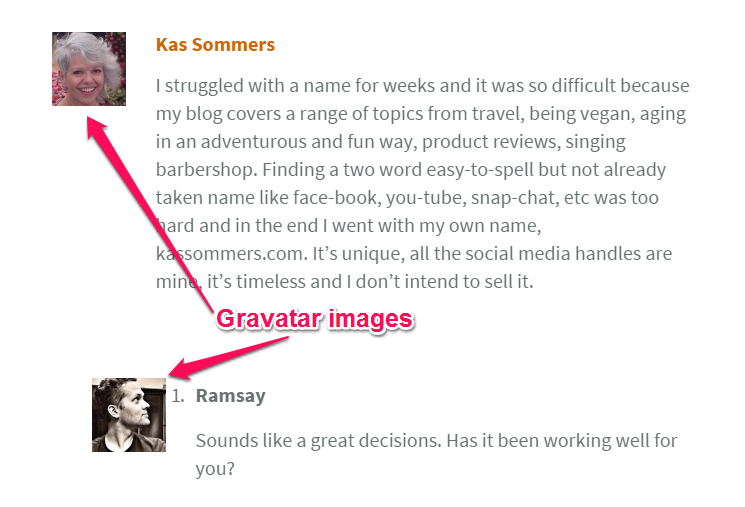
Your Gravatar image says a lot about you. At a glance, you can see that Ramsay’s Gravatar is his real photograph.
Many blogs today access the Gravatar system, so when you write WordPress comments on a blog post or post in a forum, the icon next to your comment is the image that you want it to be, not just some random generic icon that doesn’t represent your personal brand.
Most people probably wouldn’t attribute any WordPress blog commenting success to their Gravatar image, but I can tell you that it absolutely helps shape a more customized, branded web experience for yourself and others.
Some people set up a Gravatar years or months ago and haven’t checked it since.
Now’s the time to fix that. You need to log back into your account and update your photo. Ideally, use a more personal photo that clearly defines what you stand for.
In a recent blog post, Gravatar said that, “If you’re using a low-resolution image of yourself that you cropped from a friend’s Facebook photo two years ago, then it’s time for an update.”
Gravatar has been upgraded to handle images up to 2048px, so you can choose high-resolution images. You don’t want your avatar image to look pixelated, as if it was taken from an 8-bit Super Mario Brothers game.
It’s always wise to present a professional appearance, regardless of what service you render or product you offer for sale. A professional photo will likely increase your perceived value.
If you don’t have a smartphone with a high megapixel camera for taking snapshots, you should get a nice portrait done by a professional photographer.
Here are some more reasons why your avatar image is so important:
i). It is part of your branding: Branding is the totality of your business. According to Bop Design, “45% of a brand’s image can be attributed to what it says and how it says it.”

Don’t just write helpful comments and leave it there. Take it a step further and let people know who’s actually commenting and representing your brand.
ii). It improves authority: Getting noticed is important. But commanding attention and influencing people to join your list and buy your product happens only when you have authority.
Until you influence people, you’re not truly an authoritative personality. Authority is usually built and strengthened when you’re not hiding behind the curtains.
Leaving comments with your real image beside them could have a multiplier effect on your authority. You’ll become influential and people will regard you as an expert in your niche. Credibility usually gives birth to authority.
iii). Motivate potential clients: How do you get prospects excited about your services and products if your Gravatar image looks like a cartoon or lifeless object?

Remember that potential clients usually hang out on the same blogs that you read and comment on every day. If you appear real, they’ll be more motivated to take you up on your offer.
One of the things you should do if you want your comment to be noticed is to use a Gravatar image with a crystal-clear background color.
Pat Flynn uses black background to make his Gravatar image stand out from the crowd. This contributes to the overall trustworthy, professional “vibe” – together with the value delivered in his comments.

Here’s another professional Gravatar. Even though the commenter didn’t use his full name, the Gravatar image helps the comment stand out.

To connect your email address to Gravatar, follow these simple steps:
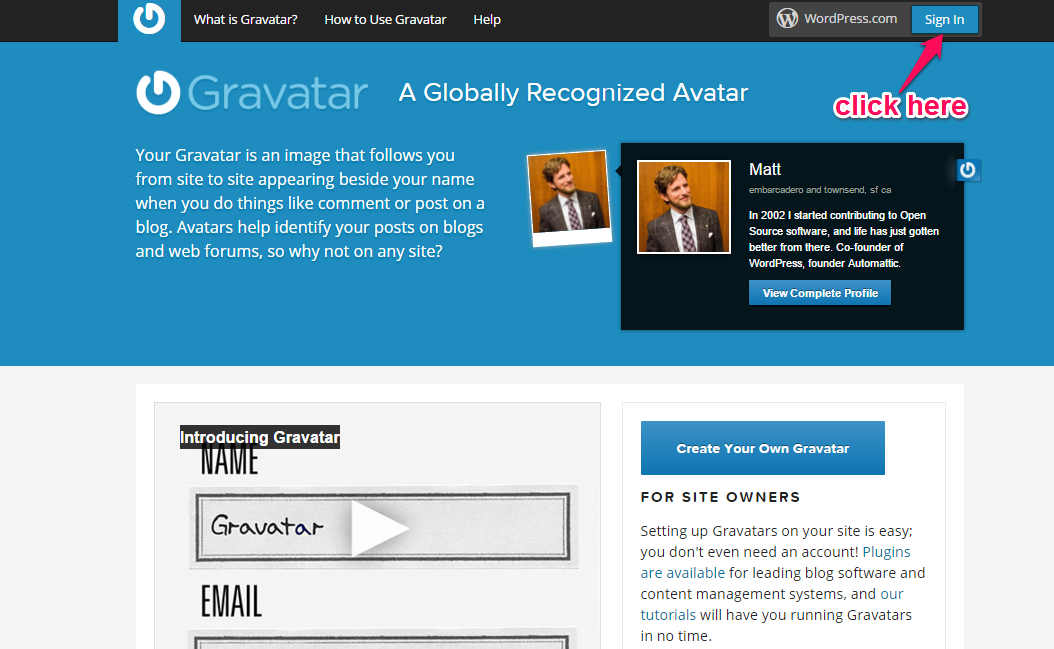
ii). Second step: Add new image. Select your personal photo from your computer.

Next follow the step-by-step prompts and you’ll be done in just a few minutes. The next time you leave a comment using the email address that’s attached to a Gravatar, your comment will appear like this:

A quick note: There’s no rule that says you can’t use your logo as a Gravatar image. For various reasons, you might prefer to promote your brand to your target audience using a logo or unique icon.
Listen up: The very fact that most people use their real photograph as a Gravatar doesn’t mean they’ll be transparent or real to their audience. The question is, “How can you be sure that the Gravatar photograph you saw was actually from the real blogger or influencer?”
Glen Allsopp uses his blog logo as a Gravatar image. And some people relate to this more, because they know that the logo belongs to Glen and him alone.

5. Leaving comments on non-industry blogs
Remember that blog post about how I generated $25,000 from 249 comments? Out of these comments, about 3,973 visitors clicked on my link and landed on my blog. I was able to convert 6 consulting leads and turned one of them into a $25k speaking gig.
What you may not know is that I wasn’t just throwing my comments up on any blog I happened to run across. On the contrary, I was very selective.
I have to admit that 25 of the comments were basic. I only wrote one or two phrases and really didn’t bring much value to the article.
And, I got the meager results to show for it. I couldn’t expect anything better. A perfect example of a basic comment is:

No, I didn’t add value to the conversation. But over time, I improved my comments considerably:

The moral of this case study is that not all blogs are created equal. It really matters which blogs you read and leave comments on.
I was able to generate decent traffic to my site and increase my income because out of the 224 comments that were truly useful, 100 of them were on industry blogs, while 52 were on mainstream blogs such as Huffington Post, Mashable, etc.

The truth of these blog commenting tips is that if you’re leaving comments only on non-industry blogs, you won’t drive a lot of traffic to your blog, because the people who will read your comment aren’t targeted to your offers.
For example, let’s say you’re a search engine optimization expert and your landing page is about optimizing for long-tail keywords.
If you leave a comment on Huffington Post, the majority of those readers aren’t into search engine optimization and may not understand what your landing page is about when they get there.

From a branding perspective, having your comments on industry blogs will improve your brand and expose you to those you’re trying to reach. A few people have told me that they saw my name popping up on different blogs.
There’s no doubt that if you spend adequate time writing comments and responding to them, especially on industry blogs, you’ll generate better leads and search engine optimization as a result — not merely visitors.
To find industry blogs that will drive targeted visitors and leads to your blog from your valuable comments, follow these simple steps:
i). First step: Go to SEMrush.com – On the homepage, input your blog URL (e.g., quicksprout.com). Click the search button:

ii). Second step: Analyze your competitors – On the results page, scroll down and you’ll find your “main organic competitors.” Those are the industry blogs you should start leaving useful comments on.
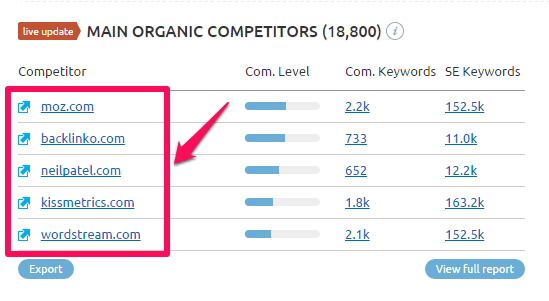
6. Writing comments that aren’t relevant to the topic
Is your comment relevant?
Often times we want to get our comments on a popular blog without considering the topic that’s being covered.
Of course, there’s nothing wrong with writing a comment on a non-industry blog, because you’ll still get traffic to your blog, even though these visitors may not convert into leads.
But never make the mistake of writing comments that are unrelated to the topic.The major reason why most brands don’t activate the comment system on their blogs or actively comment on other blogs is because of comment spam like this…

One thing is certain: If the comment isn’t in any way related to the topic, it’s spam. And you know where comment spam usually end up – in the trash.
When I read some comments, I begin to wonder what the commenters were thinking at the time. Trust me, nothing annoys a content writer or blogger more than an unrelated comment.
When you read success stories of people who have used blog comments to grow their business, you should dig deeper to know how they did it.
Sujan Patel generated 513 leads to his startup by commenting on blogs. Not just any type of comment, but relevant, valuable, and rich comments.
In other words, if he reads an article about “growth hacking,” his comments will be related to growth hacking and not blogging. Sure, he can still talk about social media when the topic isn’t connected to that, but “bridging the gap” is what makes the difference.
Here’s how Sujan drives leads through commenting on blogs:
i). First step: He searches for relevant articles. What’s your goal? Before leaving a single comment on any blog, ask yourself, “what do I stand to gain?”
[S]ince the goal of this strategy was to gain leads for a content marketing tool, I began searching Google for terms such as ‘content marketing tools’ and ‘content marketing resources.’
If you’re going to increase your search engine optimization and attract targeted traffic to your site or landing page through your comments, you need to search for relevant articles. You can add search engine operators like Sujan did when he added an advanced search engine operator “inurl:blog.”
When he searched with the operator alongside the keywords, irrelevant results were filtered and only search engine results from blogs or articles that could be commented on were served.
He deliberately chose where to comment. You should do likewise. Don’t comment on a blog just because they’re your competitors. If the specific topic isn’t related to your offer, landing page, or purpose, you’re not under any obligation to leave a comment.

ii). Second step: Choosing where to comment – When you do a search in Google for articles and blog posts to comment, you’ll likely find a lot of them. Making a choice at this point is critical.
It’s important to visit the site and analyze the site authority, traffic, page views estimate and the social media influence. Do the posts from this blog get shared?
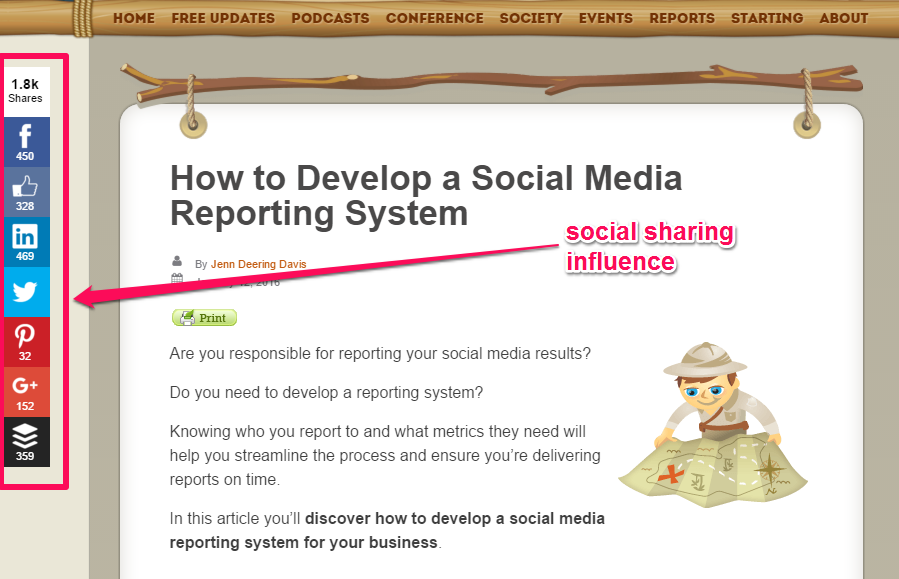
Sujan Patel had a great strategy. He perceived that articles on the first page of Google for his search terms were a good fit, since they were highly ranked. This also meant that they were likely to receive regular traffic.
Quick search engine optimization tip: Make sure to log yourself out of Google and go “incognito” (if you’re using Chrome, at least).

The incognito window is very powerful. It’ll prevent personalized search engine mechanisms from skewing the search engine results you see to align with sites and web pages you’ve visited recently or visit frequently.
You can read the complete case study of how Sujan Patel got 513 leads from commenting on blogs and learn how you can do it, too.
7. Asking questions instead of contributing and vice versa
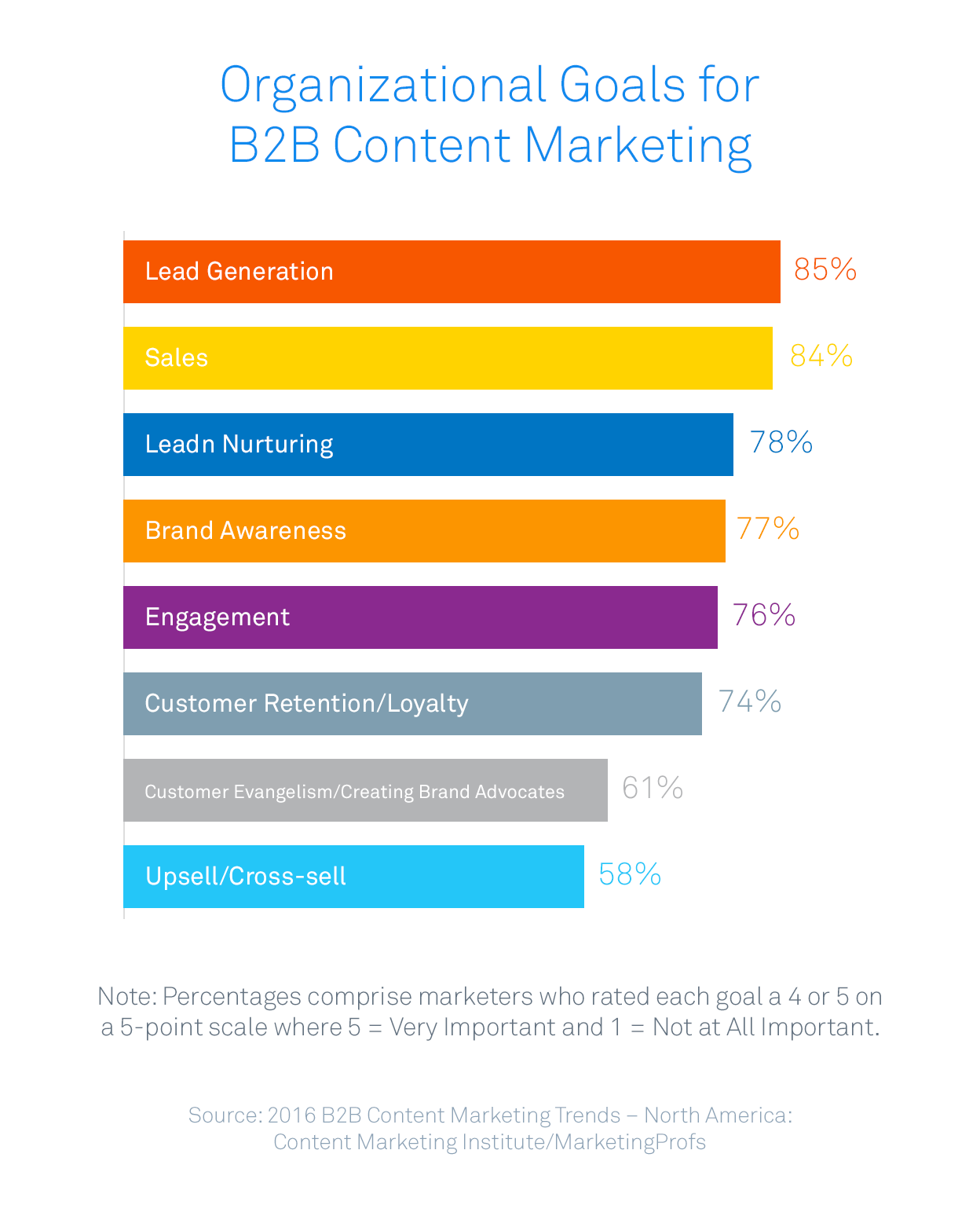
I’ve shared with you several ways that commenting on the right blogs in the right ways can increase your chances of acquiring better leads.
However, some people go slightly overboard when dropping comments on industry blogs. Yes, the blogger wants and values comments. But the “content” or “substance” of the comment is so important.
What do you say in your comment? Should you ask a question or add your two cents?
Well, it all depends on what you want. For example, if you read a post on a topic you’re not an expert on, it would be unwise to assert your own opinion as fact.
In that situation, you should simply ask a question. Then the blogger should be able to throw more light on complicated or complex sections.
I recently got an important question from a reader who decided to leave a comment. Take a look:
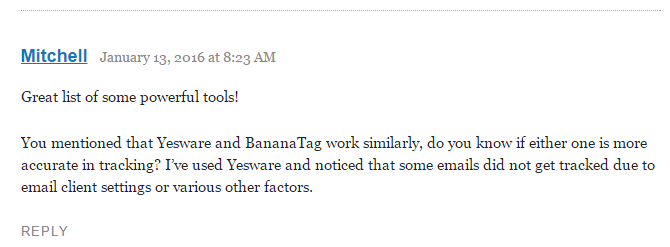
Meanwhile, here’s another instance where the reader made a recommendation in a comment. He goes as far as letting us know why he chooses Klear.com over other tools.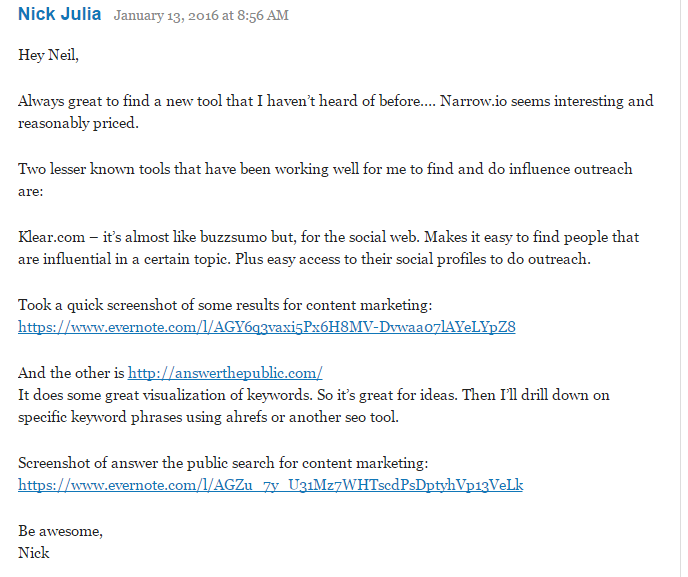

In a nutshell, if you’re knowledgeable about the topic, then add your contribution (e.g., make a suggestion, recommend a tool, a resource). But if you’re a beginner, don’t be shy about asking a question.
8. Writing a spammy comment
The word “spammy” is something of a vague word. It goes beyond what robots spread throughout the web. Even well-intentioned humans can sometimes disagree over what exactly constitutes comment spam.
Whether it’s email, links, web pages, or comments, spam is all around us. In fact, it’s estimated that 80% of global email traffic is spam.

So what’s the accurate definition of “spammy”?
Let’s allow Google to pull an answer from its index:

When it comes to commenting on blogs, you must do your best to eliminate comment spam. If you’re going to contribute, ask a question or add your own opinion, do it like a real human being who cares.
- Use your real name
- Use your full name
- Use a valid email address
- Use and updated gravatar
- Link out to a relevant page (this is optional)
- Address the author or blogger by their first name before leaving your comments
- Don’t write a one phrase comment (e.g., great post Neil)
- Don’t copy and paste an article and use it as your comment
- Stick to the topic.
- Comment on industry blogs more often
- Don’t ignore mainstream blogs (e.g., Mashable, Forbes)
Commenting on blogs by following the site’s guidelines is a great way to drive referral traffic, social media signals and leads to your business.
If you don’t have the time, you should hire someone to do it for you, because every marketing tool or channel is an integral part of your content strategy.
Conclusion
Along with blogging itself, commenting on blogs is a truly unique way to start driving visitors to your blog and improve your overall search engine optimization. People who don’t see results probably haven’t been doing it the right way.
The rules aren’t set in stone, but that doesn’t mean you can throw comment spam up anywhere and expect people to come to your site.
Again, if you want your comment to stand out, you should do everything within your power to comment early in a blog post’s life cycle. Subscribe to top industry blogs and be alert. Whenever you receive an email for a new post, be the first to write a high-value comment.
Other comments will fall below your own and you’ll drive more targeted visitors, leads, and customers to your business.
source https://tessrijogo.blogspot.com/2019/11/blog-commenting-mistakes-you-need-to.html
Our premier Courier service in India provides global shipping to the UK, USA, Europe, Dubai, UAE, Sri Lanka, Malaysia, and Singapore, guaranteeing quick and safe delivery solutions
ОтветитьУдалить